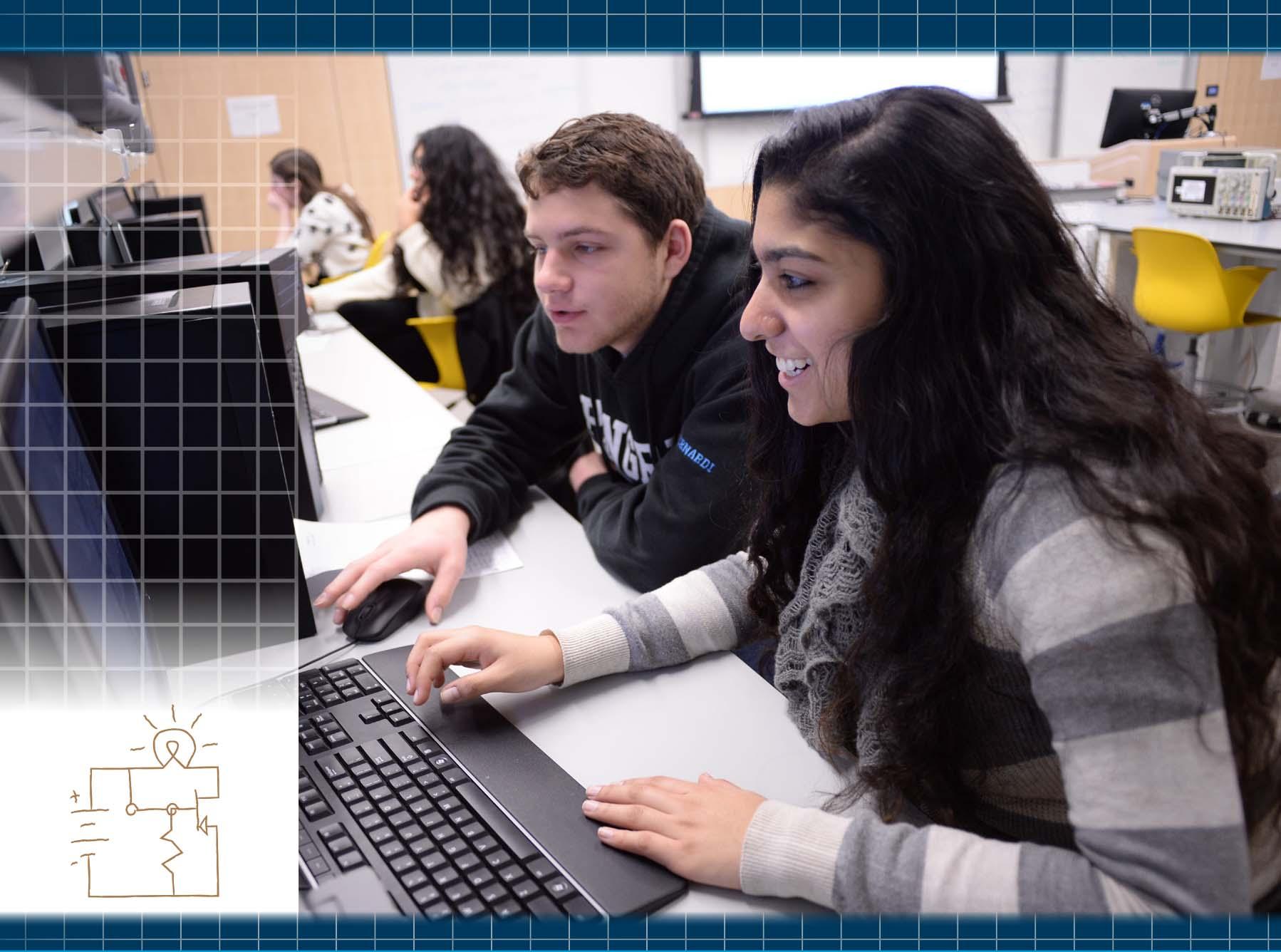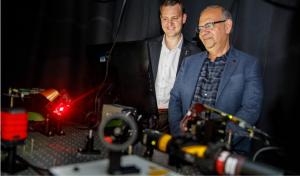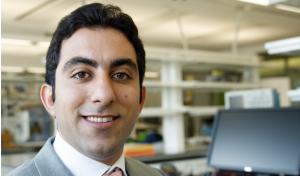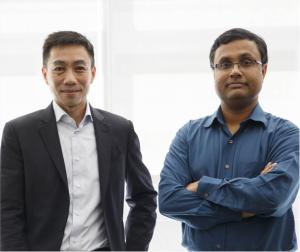Technology-oriented solutions for real-world challenges
LETTER FROM THE DEPARTMENT CHAIR
Through its unique location in the heart of the nation’s capital, the Department of Electrical and Computer Engineering at the George Washington University provides to its students a multicultural environment with access to unparalleled institutions, from the Smithsonian museums to the Kennedy Center for the Performing Arts. Further, DC is undisputedly one of the largest few tech hubs in the nation and a home to major defense/ aerospace government contractors and leading tech industry including the Amazon headquarters. Government research labs such as NASA Goddard Space Flight Center, the Army Research Lab, the Naval Research Lab and the National Institute of Standards and Technology (NIST) complement this unique ecosystem. No wonder our greater DC area is among the very top in the number of tech employees, data centers and internet traffic, all of which offers enormous opportunities to our students and faculty.
Our faculty are world class leaders who include five IEEE Fellows, a recipient of the IEEE Computer Society Edward J. McCluskey Technical Achievement Award, a recipient of the Alexander von Humboldt Research Award, a recipient of the U.S. Presidential PECASE Award, and many other prestigious recognitions. Leading government research agencies sponsor the cutting-edge research being conducted in our department with millions of dollars every year, under the supervision of our faculty. Sponsoring agencies include the National Science Foundations (NSF), Defense Advanced Research Program Agency (DARPA), Office of Naval Research (ONR), Airforce Office of Scientific Research (AFOSR) to name some. Our cutting-edge research program and innovations include future technologies for AI and Computing; cyber security at scale; energy innovation in the Arctic, among others.
Tarek El-Ghazawi, Ph.D., IEEE Fellow
Professor and Chair,
Department of Electrical and Computer Engineering
FUTURE TECHNOLOGIES FOR AI AND COMPUTING
Professors Tarek El-Ghazawi and Volker Sorger have recently received three grants totaling over $5.1 million in funding from various institutions including the Office of Naval Research (ONR), the Army Research Office (ARO), and the Airforce Office of Scientific Research (AFOSR). Their general collaborative efforts focus on developing new processors and computers using light (i.e., photonics as opposed to electronics). The interdisciplinary work is unique in the way that it brings different research backgrounds. Prof. El- Ghazawi, ECE department chair, IEEE Fellow and the founding director of The GW Institute for Massively Parallel Applications and Computing Technologies (IMPACT) is an international authority on high-performance computing.
Prof. Sorger, 2022 Optica and SPIE fellow and PECASE award recipient, focuses closely on opto-electronic devices and circuits, plasmonics, and nanophotonics. Together they solve complex emerging issues in computing. Prof. Sorger attributes their success precisely to this which drives their innovation and outside-the-box thinking. To date, Drs. Sorger and El-Ghazawi have begun the process for and received well over a dozen patents for this technology. Their efforts to commercialize the technology they are working on has been supported by the Technology Commercialization Office.
Professor Ahmed Louri, David and Marilyn Karlgaard Endowed Chair Professor, IEEE Fellow and the recipient of the IEEE Computer Society Edward J. McCluskey Technical Achievement Award in 2020 is investigating novel parallel computer architectures and network-on chip technologies supported by two recently awarded grants from the National Science Foundation (NSF). These awards bring the total amount of federal funds for this research topic to $4.5 million over the past three years. One of the projects aims to develop a holistic framework spanning architecture design, Network-on-Chip design, machine learning algorithms, and algorithm architecture co-optimization to design energy-efficient and high performance scalable accelerator architectures for graphs neural networks. ECE efforts in future of computing, led by professors El-Ghazawi, Sorger, and Louri have resulted in many publications and patents to date.
COMBATING WILDFIRES IN THE ARCTIC: AN ENERGY RESILIENCE APPROACH
ECE Assistant Professor Payman Dehghanian and his team were awarded a $2.82M NSF contract for the project, “Foundations for Improving Resilience in the Energy Sector against Wildfires on Alaskan Lands (FIREWALL)”, a four-year multi-institutional multidisciplinary effort among GW, the University of Alaska at Anchorage, the University of Alaska Fairbanks, and Washington State University. The national effort is supported by the Navigating the New Arctic (NNA) program, one of NSF’s 10 Big Ideas that supports fundamental convergence research across the social, natural, environmental, engineering, and computing & information sciences. Alaska has witnessed high-intensity wildfires that are projected to increase due to climate change and present new and emerging risks to Alaskan energy infrastructure and communities needing electricity for daily life and services. Alaska is especially vulnerable to wildfires due to its isolated electricity grid, its fire-prone boreal forests, and extreme fire behavior, as well as the critical dependence of its rural communities on electricity for health and year-round food supply.
Prof. Dehghanian, the 2022 GW Office of Vice Provost for Research (OVPR)’s Early-Career Researcher award winner and the recipient of the 2021 Washington Academy of Sciences’ Early-Career Award and GW School of Engineering and Applied Science (SEAS)’s Outstanding Early-Career Researcher Award in 2022, conducts cutting-edge research on the main theme of enhancing the resilience of the nation’s electrical power delivery infrastructure against extremes. He works with a diverse team of researchers with seasoned expertise in electrical power systems engineering, energy law, decision sciences, social and environmental sciences, nursing and health to collaboratively design and develop next-generation solutions that ensure the resilience of both Alaskan energy infrastructure and communities against wildfires. The FIREWALL research project will aim to advance the knowledge on (1) how elements of the natural environment, energy infrastructure, and social systems interact with one another before, during, and following wildfires, and (2) how to enable collaborative decision-making and communications among multi-sectoral stakeholders to reduce wildfire risks faced by communities and electric utilities. Working hand in hand with a variety of stakeholders, this synergistic approach aims to build trust and empower the Arctic communities, electric utilities, emergency responders, and health organizations with a collaborative capacity to conjoin resources and exchange information for better situational awareness in response to wildfires.
INDIVIDUALIZING SECURITY AND HUNTING THREATS AT SCALE
In an increasingly interconnected world dependent on technology, two ECE researchers are developing a way to keep computer systems safer from would-be hackers with a new approach that would eliminate security loopholes before they can be exploited. ECE Professors Tian Lan and Guru Venkataramani collaborate on a $1.47M grant from the Office of Naval Research titled: “DIALECT: Communication Protocols Customization via Feature Diagnosis, Lacing, Elimination, Cross-grafting, and Trimming”, to study how customized software packages could individualize security in cyber systems by customizing their protocols which would in turn reduce security risks and foster a more resilient system. While software programs are consistently releasing new updates, new loopholes are inadvertently created as the size of the system swells. Standardized versions of common software, like Microsoft Word or Adobe Flash Player, are running on countless machines, which gives potential aggressors the possibility to inflict widespread damage if hackers discover a backdoor into such widely used software systems. Prof. Lan and Prof. Venkataramani believe system security could be improved with customized versions of essential software that only includes features a specific user or company needs. Prof. Venkataramani and Prof. Lan are developing a way to use machine learning to comb through these kinds of software to detect which parts are being used and which are not. From there, they will be able to create customized packages that cut out redundancies and unused features.
On a related research theme, Professor Howie Huang’s Graph Computing Lab (GLab) takes a holistic approach for modeling and analyzing users and machines in enterprise networks. His research aims to analyze the dynamics of the networks to identify cyberattacks as they happen and prevent new ones from happening. Professor Huang and his students are designing and developing novel graph-based machine learning systems, to not only manage the big data generated by these networks, but more importantly, to understand the contextual and causal relationships between entities and events in such networks. Professor Huang’s lab currently works on the CHASE (Cyber Hunting At Scale) project, sponsored by the Defense Advanced Research Projects Agency (DARPA). Innovating at the intersection of algorithms, systems, and applications, Prof. Huang and his students aim to enable knowledge mining and extraction on top of large-scale networks, delivering critical, actionable knowledge to stakeholders in real time. The outcomes of his DARPA project are innovative methods for precise and effective threat detection in enterprise networks. Prof. Huang believes that ultimately his research efforts will lead to new paradigms in AI, machine learning, cybersecurity, and more.
EFFICIENT COMMUNICATION NETWORKS: FROM EDGE TO DATA CENTERS
Professors Suresh Subramaniam, Omur Ozel and Guru Venkataramani have received a three-year NSF grant to work on an expedient computing framework for energy-efficient and timely computing at the edge.
The motivation behind this work is that emerging and future cyber-physical system applications demand timely processing at the network edge of large volumes of fresh data from sensor nodes, which may have limited processing ability and energy budgets. This project will draw upon the cross-disciplinary expertise of the investigators.
Professor Subramaniam, IEEE Fellow and a well-known expert in the area of communication networks. Professor Ozel, focuses on next generation networked systems under dynamical energy and information freshness constraints. Professor Venkataramani is a renowned expert in computer architecture with an emphasis on security and energy efficiency. Professor Subramaniam also collaborates with researchers at MIT, working on replacing current data center communications with optical networks to increase the computer clusters speed and reduce their power consumption.
The team’s goal is to develop a new holistic framework called expedient computing, in which results are produced as quickly as needed, with as much precision/accuracy as needed, using information that is as fresh as needed. Optical communication relies on light to transmit information using laser signals and is more efficient than electronic communications systems such as wireless and wireline networks, which consume more power and take more time to process information.
NEXT-GENERATION ELECTRONIC AND PHOTONIC CHIPS
Assistant Professor Gina Adam works on several interdisciplinary projects aiming to develop robust prototyping capabilities for new synaptic devices, called memristors. She is leading a collaboration with neuroscientists from George Mason University to draw inspiration from the brain structure in the design of next-generation neuromorphic chips. The project supported by the Department of Energy investigates how the brain performs robust computation despite its unreliable synapses and develops new algorithms and architectures resilient to existing memristor imperfections. Prof. Adam also works on engineering superior memristors using the GW Nanofabrication and Imaging Center. Moreover, Prof. Adam is contributing as a research partner to develop a nanotechnology accelerator platform in
collaboration with the National Institute of Standards and Technology (NIST) and Google, together with groups at University of Michigan, University of Maryland, Brown University and Carnegie Mellon University. This community building effort is envisioned as an opportunity for university researchers working on novel electronic devices to pursue their heterogeneous integration on silicon-proven circuitry in line with the CHIPS act.
Professor Mona Zaghloul is also a heavy user of our GW Nanofabrication and Imaging Center, working on next generation sensing chips and biosensors to detect COVID-19 virus in partnership with professor Jeanne Jordan from GW Public Health School. Prof. Zaghloul is also studying two-dimensional materials and their piezoelectric properties for sensor applications.
In the next door lab, novel photonic chips for neuro-inspired computing are being developed by Professor Volker Sorger, as part of the newly AFRL/ AFOSR funded Center-of Excellence ExPlor and the SRC/DARPA JUMP Center for Heterogeneous Integration of Micro Electronic Systems (CHIMES). His group has developed a new approach to perform computations required by a neural network, using light instead of electricity. Such a photonic tensor core performs multiplications of matrices in parallel, improving the speed and efficiency of current deep learning paradigms. Prof. Sorger is developing this photonic system by strategically utilizing photonic parallelism via wavelength division multiplexing and novel photonic multi-state memory devices based on phase-change materials. It promises high throughputs enabled by ultra-short delays from the advanced optoelectronics and compact photonic integrated circuitry to support the looming 5G networks and beyond.
Download the ECE Department Brochure (pdf)












